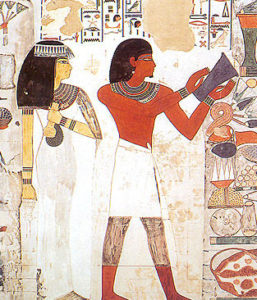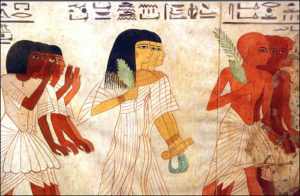I saw this video on FB and was really moved by it. Every person in it is extraordinarily beautiful, to remind us that even exceptional beauty and youth does not protect you from the pain and unfairness of color bias.
In the video, USC’s Dr. Lanita Jacobs points out that colonization and slavery play a role in beauty standards today, which is, of course, of no surprise to anybody who is paying attention. But what really struck me is that colorism may go even deeper than that.
I was thinking about ancient Egyptian art where men were often painted in a reddish-brown pigment while women were depicted with a lighter, more yellowish cast. According to Egyptologists, this convention was a marker for wealth and status because it demonstrated visible proof that the woman did not have to work outside, or even go outside–where the sun would naturally darken her skin–as men did.

 Which tells us that even in ancient Egypt, beauty standards were deeply tied into notions of wealth and power. It’s no surprise that we see so many of these depictions–after all, only the wealthy could afford ornate tombs in the first place.
Which tells us that even in ancient Egypt, beauty standards were deeply tied into notions of wealth and power. It’s no surprise that we see so many of these depictions–after all, only the wealthy could afford ornate tombs in the first place.
We see this too in some other ancient cultures, such as Minoan, where upper class women were painted as being very fair, while men were painted in darker shades, likely for the same reason–rich women did not have to work outside while men freely worked and played outside.

 Again, wealth, status and power dictate, but structurally, underneath all the colorism, is the idea of “ownership” of women–women as property, as objects, where even their skin tone was a measure of male wealth, power and status.
Again, wealth, status and power dictate, but structurally, underneath all the colorism, is the idea of “ownership” of women–women as property, as objects, where even their skin tone was a measure of male wealth, power and status.
It is true that in both ancient Egypt and Minoan civilizations, women had a bit more power and rights than they did in, say, ancient Greece where women had zero rights, were actually considered baby-making objects/property, and were barely above slaves in status. But even societies where women had more rights and freedoms, “paleness” was the standard of beauty for no other reason than it showed family wealth, power, and status.
I don’t know how this adds to the conversation except to remind us that racism is deeply intertwined with issues of class, power, gender, and wealth. Scratch one and find the other and vice versa.
We’ve stopped mummifying people for some magical afterworld. Can we stop this too?


Wow – that is a great video! And they are all beautiful! e